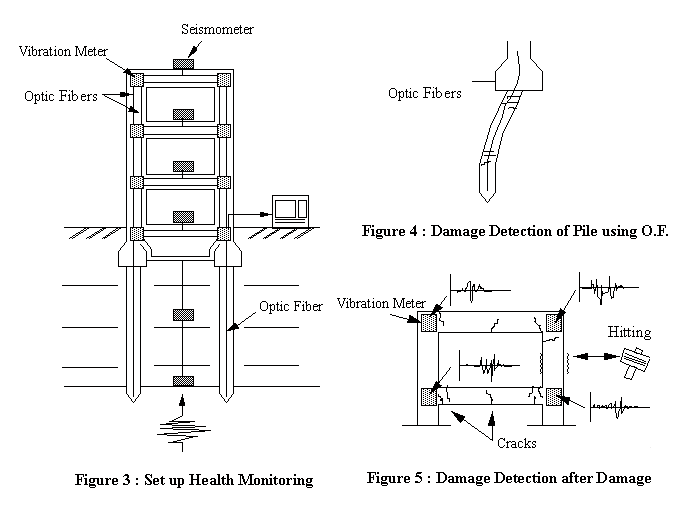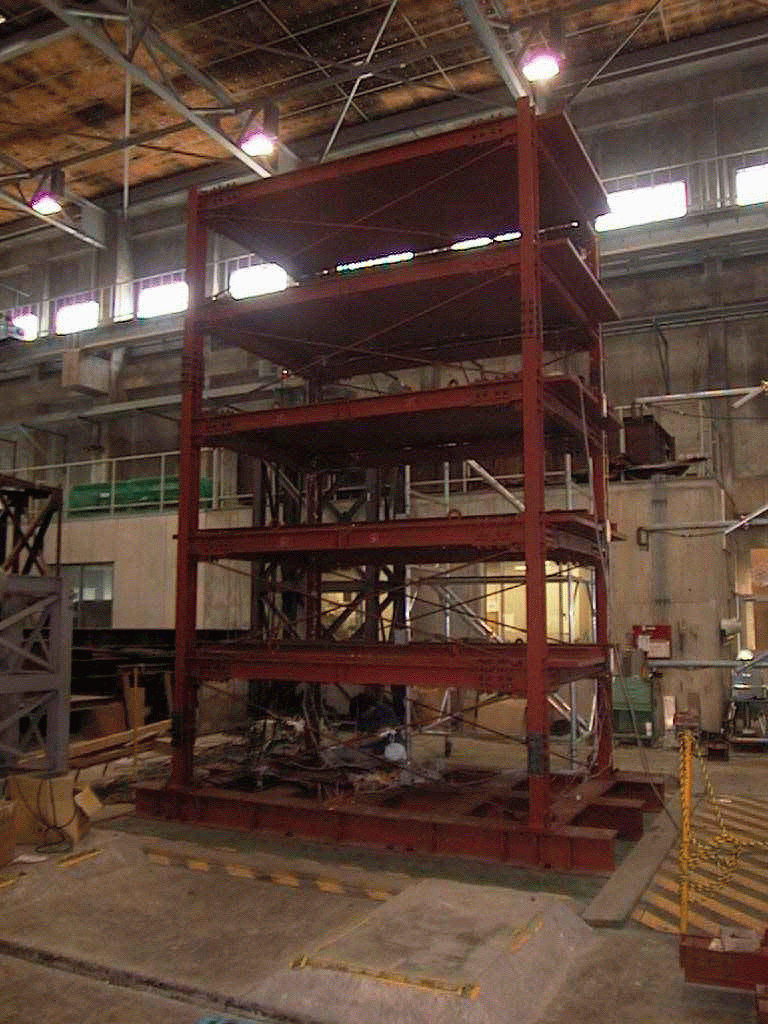
US-JAPAN COOPERATIVE RESEARCH PROJECT ON
Building Research Institute, Japanese Ministry of Construction, initiated a 5-year research and development project of "Smart Materials and Structural Systems" in 1998 as part of U.S.-Japan cooperative research efforts. U.S. Counterpart is National Science Foundation. Smart Structural Systems (also called as Auto-adaptive Media) are defined as systems that can automatically adjust structural characteristics, in response to the change in external disturbance and environments, toward structural safety and serviceability as well as the elongation of structural service life. The research and development of (1) Concept and performance evaluation method of smart structure system, (2) Sensing of structure performance, and (3) Development and evaluation of structural elements using smart materials will be conducted.
A conventional structural system is designed to achieve a set of intended
functions under pre-selected loads and forces. Such a conventional system
can not successfully develop its ability against unexpected loads and forces
unless a large safety factor is provided for safety limit states to take
into account various uncertainties in load and force amplitudes and structural
response. Furthermore, since seismic design requirements have been improved
after each bitter lessons learned through past earthquake disasters, the
safety level of old buildings is always inferior to new buildings as evidenced
in many past earthquake disasters, e.g., the 1995 Kobe earthquake disaster.
Strengthening or removal of those old buildings becomes necessary to protect
societal welfare.
Smart Structural Systems are defined as structural systems with a certain-level
of autonomy relying on the embedded functions of sensors, actuators and
processors, that can automatically adjust structural characteristics, in
response to the change in external disturbance and environments, toward
structural safety and serviceability as well as the elongation of structural
service life.
The research and development are conducted focusing on the following issues.
To achieve research objectives, following three sub-committees have been
formed under Technical Coordinating Committee of the project.
The research organization is illustrated in Figure 1. The Building Contractors Society, the Housing and Urban Development Cooperation, the Building Center of Japan, and several materials and sensors makers participate in this R/D project.

6-8, January, 2000
US-JAPAN Workshop on Smart Structural Systems -
the first JTCC of US-Japan cooperative research project -
Tsukuba, JAPAN
7-9, December, 2000
The Second Joint Technical Coordinating Committee
Meeting - U.S.-Japan Cooperative Research on Auto-adaptive Media (Smart
Structural Systems) -
Hawaii, USA
18-19 October, 2002
Workshop on Smart Structural Systems organized for U.S.-Japan Cooperative
Research Programs on Smart Structural Systems (Auto-adaptive Media) and
Urban Earthquake Disaster Mitigation
The Third Joint Technical Coordinating Committee Meeting
Tsukuba,JAPAN
Sub-committee on Structural System
The basic concept and strategies for the development of smart structural
systems should be established, and, the followings are the main targets
of research and development:
1. Definition and categorization of smart structural systems
2. Summary of the required performance of smart materials or devices to
realize the smart structural systems
3. Performance verification of proposed smart structural systems by computer
simulations and experiments
4. Established of guideline for the performance evaluation of smart structural
systems

The following three systems are currently under consideration as the smart
structural systems:
1. Autoadaptive structural systems
2. Reinforced concrete (RC) structural systems with damage fuses
3. Innovative life safety systems
The each system is researched and developed by the corresponding working
group.
1. WG for Auto-adaptive Structural System
Autoadaptive structural systems can adjust structural characteristics,
in response to the change in external disturbance and environments. These
systems are expected to show higher performances relying on the embedded
functions of sensors, actuators or processors than the conventional structural
systems.
In last fiscal year, some autoadaptive structural systems such as the smart
rocking systems, the base isolated systems with adaptive dampers and the
frame systems with the adaptive dampers or SMA devices were proposed. In
this fiscal year, the performance of the proposed structural systems will
be investigated using analytical and experimental simulations. And performance
evaluation guidelines for autoadaptive structural systems will be discussed.
2. WG for High Performance Structural System
The main objective of this working group is to develop the performance
based design/assessment methods using the damage control concept for reinforced
concrete buildings with damage fuses such as energy absorbing devices,
damage concentrating devices and damage sensor for the devices. The development
of repairing and replacing techniques for the damage fuses is also included
in the scope of research objectives. Investigated in this fiscal year was
the possibility of applying the existing performance based seismic evaluation
method such as the Capacity Spectrum Method, the Energy Input Rate Spectrum
Method and so on for RC buildings with damage fuses.
3. WG for Smart Seismic Rehabilitation System
Our group is examining the performance and resistance of seismic reinforcement
on low-rise inferior structures. We have also conducted a survey for academic
authorities, graduates and engineers. They have presented our group with
new plans with smart device and/or system for reinforcement or life safety.
The ideas that were collected were summarized into the following four methods;
1)The lifting structures, 2)The supporting structures, 3)The base-isolation
system, 4)The adaptive structures.
We are discussing verification method of performance of our final methods.
Shaking table test will be conducted at the final stage to verify their
performance.
Sub-committee on Sensing and Monitoring Technology
1. WG for Structural Performance Evaluation
Final target of this working group is to develop technology for evaluating
seismic and serviceability performance. At first contribution of non structural
elements for their performance was made clear analytically. Target structure
of analysis is real building built in the site of building research institute.
The building has eight stories and one basement, and the structure consists
of steel and reinforce concrete. As the result of analysis vibration model
for evaluating performance were proposed. In addition to this analysis,
damaged parts of this building against big earthquake were made clear using
push over analysis
2. WG for Structural Health Monitoring
Sensing and monitoring are the key features of smart structural systems,
our main target is Structural Health Monitoring. Identification methods
for detecting structural damage such as yielding, cracks, etc. using sensors
are developed. This year, we discussed pre-analytical study on damage detection
tests of five-story steel frame with simulated damages. Fiber brag grating
(FBG) sensors, accelerometers and strain gauges will be installed in this
frame. From the results of pre-analytical study, we can estimate which
story is damaged from the change of natural period or mode shape to some
extent. Damage identification method using modal analysis is shown here.
Damage detection methods from local information will be also examined,
and various identification methods will be also applied.


Exterior of Test Frame
3. WG for Information System with Sensors
The result outline of Sensor Network WG is shown below.
The sensor net work is to detect the damage of buildings and also is to
inspect a damage degree in cities. Moreover, it is to transmit the signal
to operate effectors to prevent from damage.
This WG classified a sensor network into three types of "the network
for the small scale buildings", "the network for the large scale
buildings" and "the network for the cities", according to
the scale of the buildings. As for each network, the necessary data and
the utilizing method of them are investigated.
Research organization of sensing and monitoring technology sub-committee
has been restructured since the fiscal year 2000. Reconstruction means
that performance evaluation working group and damage detection have been
integrated and new working group is named health monitoring working group.
Smart sensing working group has been established. Research and development
Items in this working group are the survey of new sensor, application technologies
of new sensors and so on.
Sub-committee on Effector Technology
1. WG for Shape Memory Alloy (SMA)
Plan of SAM working group in 2000
In this physical year, the three experiments, i.e., tension tests, compression
tests and buckling tests, will be carried out to obtain basic data about
the mechanical properties such as stress-strain relation under cyclic loading
of SMA wires and bars, buckling strength and post buckling behavior of
SMA braces. Some analytical models on stress-strain relation of SMA material
will be proposed from these data. Usage of SMA wires or bars to brace elements
or base isolation ones will be discussed and developed, and their seismic
performance will be estimated by analysis.
By T. Fukuta in BRI
2. WG for Engineered Cementitious Composites
Issue of development in the Cementitious Composites WG is damage tolerant
structural systems utilizing High Performance Fiber Reinforced Cementitious
Composites (HPFRCC) materials and elements.The purpose of this research
is to develop high performance cementitious energy dissipation devices
and steel-HPFRCC composite elements to achieve the damage tolerant R/C
structural system as a smart structural system. Those systems will have
much merit not only in sturctural performance but in durability, workability,
environmental efficiency and cost effectiveness. Feasibility study on the
other types of cementitious material, element and system like self-repairing
material is also included in this research. In the fiscal year of 1999,
the detailed research plan of each item was discussed. Also, structural
efficiency of the steel-HPFRCC system was clarified through a structural
test of column elements.
3. WG for Electro/Magneto Rheological (ER/MR) Fluids
Electro/magneto rheological fluid WG develops adaptive structure by electro/magneto
rheological fluid. In 2000, the WG is working on the following research
items.
1) Development and improvement of MR fluid
2) Research for performance evaluation of MR fluid
3) Research for modeling and evaluation method of MR dampers
4) Improvement of the technical data for the performance of MR dampers
5) Analytical study of base-isolated structure controlled by MR dampers
6) Parametric study of the SI (skeleton-infill) concepts by MR dampers
7) Study for application of MR dampers to real scale building model
4. WG for Induced Strain Actuators (ISA)
Induced Strain Actuators (ISA) can change their own shapes according to
external electric/magnetic fields, and vice versa. Recently these materials
have been widely used for the small/precision machines because of some
advantages from viewpoint of small sizes, rapid reaction, high power, high
accuracy etc.
The objectives in this study are to develop smart members for building
and to realize the smart, comfortable and safe structures. Designing guidelines
of ISA materials/devices are also discussed.
The research items and example images are as follows:
・Experimental study of ISA materials
・Development of smart structural members using ISA devices
・Using ISA as sensor materials
・Improvement of acoustic environments
